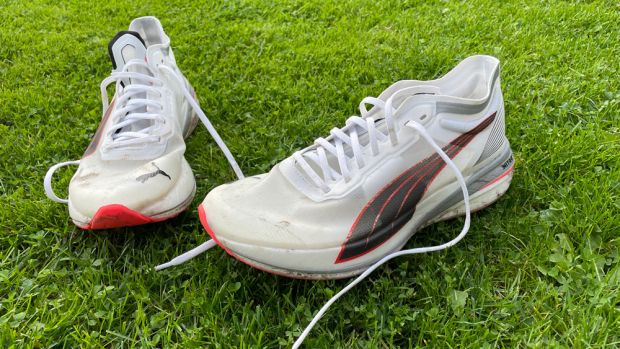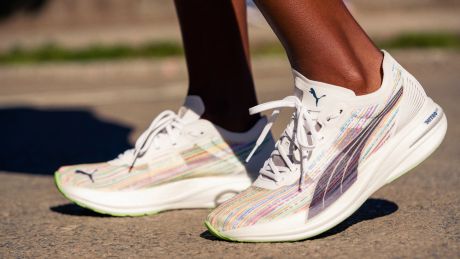Our Verdict
The Nitro Elite is a superbly fast and lightweight shoe, and being cheaper than most top carbon racers makes it even more attractive. Unfortunately, Puma never seems to have the Elite in stock.
For
- Lighter than most carbon shoes
- Bouncy and fast ride
- More stable than max-stack super shoes
Against
- Higher-stack shoes offer more protection
- It may be too firm for longer races
- Almost never in stock
You can trust Coach
Puma was one of the last brands to launch a carbon plate running shoe, but judging by the Deviate Nitro Elite it used its time wisely, developing the technology to make a great super-shoe.
Naturally that tech includes a carbon plate, in this instance a full-length model that forks at the forefoot. Perhaps more importantly, the Elite uses a nitrogen-infused PEBA-based foam, making it lighter and more responsive than the other Nitro shoes which have nitrogen-infused EVA in the midsole. The Elite weighs 201g in my UK size 9, making it one of the lightest carbon plate shoes around, and substantially lighter than the Deviate Nitro, another carbon plate shoe in Puma’s range, which weights 271g in a 9.
One of the reasons the Elite is so light is that it doesn’t have as high a stack as many other super-shoes. It’s listed as 36mm, but looks and feels a little lower. Even if it is 36mm, that’s well short of the 40mm limit set by World Athletics, whereas shoes like the Nike Alphafly and New Balance RC Elite 2 go right up to that mark.
That smaller stack means the carbon plate in the Elite doesn’t have as dramatic a curve as plates in a max-stack midsole do, and the shoe has a firmer feel than something like the Nike Vaporfly NEXT% 2. There’s still plenty of bounce and propulsion, but it’s not the match of the Nike or New Balance carbon shoes.
The upper of the shoe is very thin and, in the model I tested, see-through, which made it feel even lighter. The Elite fits a little more tightly than Puma’s other shoes I’ve tested in the Nitro range, but I was still comfortable wearing my normal size with enough room in the toe box. A little tightness is no bad thing in a racing shoe, when you really want your foot to feel locked down.
Having experienced heel rubbing with both the Deviate Nitro and Liberate Nitro shoes, I was concerned this would be the case with the Elite as well. However, the tighter fit does seem to have largely resolved this. The rubbing was so minimal I only noticed a small mark when I took my socks off after a run. I even used the Elite for 60km of running in the space of four days at one point without any noticeable problems.

In total I’ve done more than 70km in the shoe including a 5K race and several long workouts as part of marathon training. It impressed me throughout, and although it’s not as cushioned and protective as some options, it still helped me to run fast whether I was fresh or carrying fatigue.
The 5K race came after two days of long runs so I was tired going in, but I held a solid pace to run sub-16 minutes – not far off my PB pace. On another occasion I went into a chunky track workout feeling knackered and was surprised at how easily the target pace for 1km reps came to me. The foam in the shoe does add some bounce, and the plate certainly helps to energise each step so you can lock in to a pace and hold it even when tired.
Then there’s the weight of the shoe, which is light enough to allow you to kick on if you are feeling fresh at the end of a race or rep. Some other carbon shoes are becoming slightly cumbersome, if not actually heavy, so it was refreshing to run in a relatively stripped-back model.
See related
- Puma Velocity Nitro Review: The Best Running Shoe For £100
- The Best Carbon Plate Running Shoes Of 2021
- The Best Marathon Running Shoes For Training And Racing
- The Best Running Shoes
However, when it comes to the crunch, I’d prefer a more cushioned option myself for a half or full marathon. The Elite would not be a bad marathon shoe at all – indeed Molly Seidel wore it to win bronze at the Olympic Marathon in Tokyo, but we are not all Molly Seidel, alas. Most amateurs will benefit from the extra cushioning of a shoe like the Nike Alphafly or New Balance RC Elite 2.
Over shorter races it’s more of a toss-up, and the Elite will help you crack out some fast 5K and 10Ks. The outsole is not the same excellent PUMAGRIP material found on the other Nitro shoes, but a stripped-back version of this called PUMAGRIP LT, and it is still impressive for finding traction through tight turns on wet roads.
If you already have a carbon shoe, or multiple carbon shoes, in your arsenal, the Deviate Nitro Elite is not so amazing it’s worth splashing out another chunk of money on it (unless you really want all the carbon shoes). If you’re new to the carbon scene, however, it’s another great option, especially if you are used to racing flats and aren’t sure about using high-stack, soft shoes for your events.
The Elite is also relatively good value at £170 – I don’t think there’s a pure racing shoe I rate as better that is available for less. The only problem is that it’s not always easy to come by: the Elite’s latest release sold out rapidly on the Puma site, no doubt aided by both Seidel’s success and the brilliantly colourful Spectra design.
Buy from Puma | Buy from Pro:Direct Running | £170

Nick Harris-Fry is a journalist who has been covering health and fitness since 2015. Nick is an avid runner, covering 70-110km a week, which gives him ample opportunity to test a wide range of running shoes and running gear. He is also the chief tester for fitness trackers and running watches, treadmills and exercise bikes, and workout headphones.

